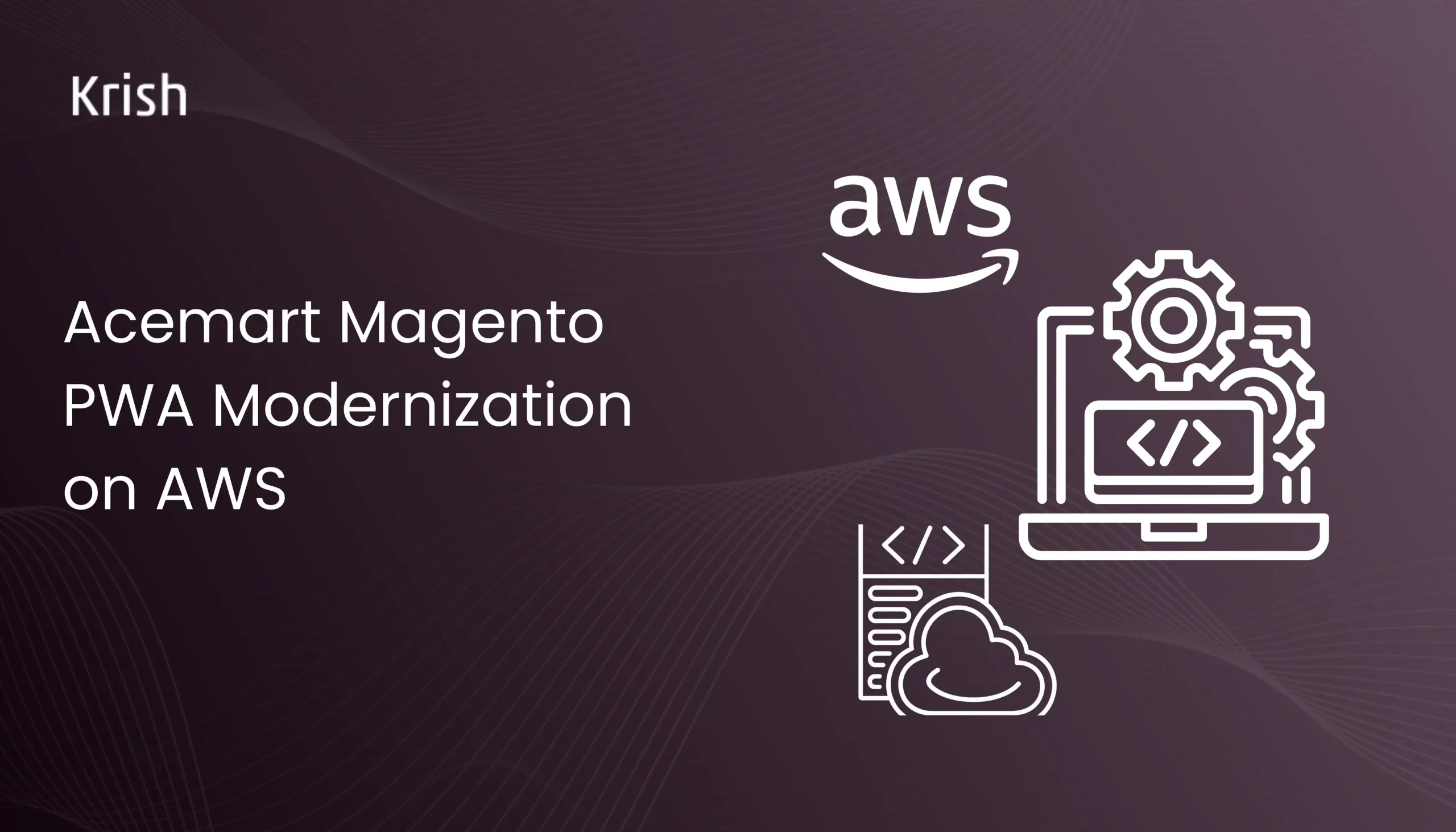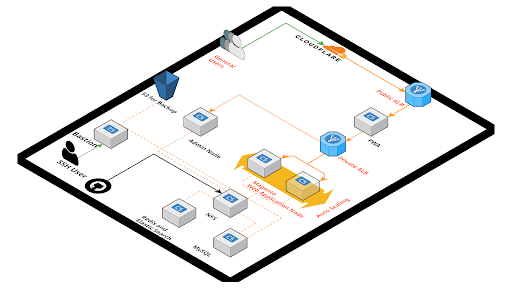
Modernizing for Stability, Efficiency, and Predictable Growth
Acemart, one of the most trusted restaurant supply brands in the United States, operates a large Magento PWA storefront serving thousands of customers across the country. With a vast product catalog and a fully digital order management workflow, the brand depends heavily on a stable, high-performing, and cost-efficient infrastructure. Their previous setup, however, offered neither the transparency nor the predictability they needed. High annual hosting bills, limited operational visibility, and heavy vendor dependency had become ongoing obstacles to efficiency and long-term scalability.
To overcome these challenges, Acemart partnered with Krish to re-architect their digital infrastructure on AWS. The goal was to replace an inflexible, vendor-managed environment with a right-sized, scalable, and transparent cloud foundation that aligned performance with actual usage. Through this strategic shift, Acemart achieved a remarkable 50% reduction in annual infrastructure spend, eliminated operational bottlenecks, and experienced zero major downtime incidents over a two-year period. With AWS powering their Magento PWA, the brand now operates on a cleaner, more controlled, and future-ready infrastructure model that supports continuous digital expansion.
“Efficiency isn’t just about saving costs, it’s about gaining clarity, control, and confidence in every transaction.” This philosophy reflects the transformation Acemart aimed to unlock through cloud modernization.
The Underlying Challenges Driving the Need for Change
Before the migration, Acemart was working with a third-party infrastructure setup that constrained nearly every aspect of their operations. Annual hosting costs had grown disproportionately without delivering equivalent value, and the rigidity of the existing environment made it difficult to adjust performance or scale intelligently. The team lacked visibility into how resources were being consumed, which meant issues were often detected late, and optimizations were nearly impossible to plan proactively.
This lack of transparency translated into operational inefficiencies as well. With no direct control over provisioning decisions, Acemart was forced to rely on their vendor even for basic infrastructure changes, delaying deployments and extending the turnaround time for addressing production issues. During high-traffic periods, the platform was frequently exposed to instability risks because scaling wasn’t tuned to real workload patterns. These recurring pain points eventually impacted internal workflows, slowed experimentation, and created limitations that restricted long-term digital growth.
It became clear that the brand needed an architecture that allowed flexibility, real-time visibility, and the ability to scale on demand, without paying premium costs or depending on external intermediaries.
The Krish Solution - Right-Sized AWS Architecture for Predictable Performance
Krish began the engagement with a comprehensive assessment of Acemart’s existing infrastructure, including workload behavior, cost contributors, and operational dependencies. This analysis revealed multiple inefficiencies, including overprovisioned resources, lack of automated scaling, restricted access to performance data, and a heavy reliance on manual vendor-managed deployment processes. Based on these findings, Krish recommended a complete migration to AWS, designed specifically to support Magento PWA workloads with high availability and predictable cost management.
The new AWS environment was engineered around right-sized compute using EC2, layered with Auto Scaling to align capacity with real traffic patterns while eliminating unnecessary spending during low-activity periods. The introduction of centralized observability through CloudWatch gave Acemart full visibility into system performance, alerting, and log analytics for the first time. This helped the team transition from reactive problem-solving to proactive optimization.
A secure and well-structured VPC ensured controlled connectivity for back-office operations, while IAM policies enforced access governance and reduced security risks. By shifting to AWS’s consumption-based model, Acemart gained the ability to refine performance without overpaying and regained full control over resource provisioning, deployments, and optimization choices. The result was a cleaner, leaner, and more resilient infrastructure that aligned precisely with business needs.

The Strategic Approach - Building a Cloud Foundation for Long-Term Control
The strategy behind the migration centered on reducing infrastructure friction while increasing Acemart’s autonomy. The first major step was eliminating the costly dependency on a rigid third-party hosting provider. Moving to AWS allowed Acemart to directly control how resources were allocated, scaled, and monitored, bringing transparency into both performance management and cost governance.
Krish focused heavily on right-sizing the environment so that compute resources matched real-world load patterns. With performance tuning and automated scaling in place, the platform could respond more intelligently to activity spikes, minimizing instability that previously emerged during peak periods. Governance and monitoring standards were introduced to help Acemart establish clearer oversight across environments, allowing the internal team to execute releases faster, diagnose issues earlier, and plan optimizations with greater confidence.
This shift removed long-standing operational roadblocks. Instead of relying on vendor timelines, Acemart’s engineering and digital teams were now able to work at their own pace, explore new commerce features, and invest in experience enhancements without being slowed by infrastructure limitations. The new AWS foundation not only solved current inefficiencies but also created room for future growth, making it easier to support new digital initiatives and scale predictably as business demand evolves.
Technology
- Amazon EC2
- Auto Scaling Groups (ASG)
- Application Load Balancer (ALB)
- Amazon S3
- Amazon VPC
- Security Groups
- IAM
- Amazon CloudWatch
- AWS CloudTrail
- AWS Config
- AWS Trusted Advisor
- AWS Backup
Results — A Clear Win in Cost, Stability, and Operational Control
The modernization delivered transformative results across cost, performance, and long-term operational efficiency. Acemart achieved a 50% reduction in annual infrastructure spend, bringing costs down from nearly $50,000 to approximately $25,000. This outcome was driven primarily by right-sizing compute resources, eliminating unnecessary services, and moving away from a fixed-price vendor model toward AWS’s consumption-based approach.
Perhaps the most notable outcome was the improvement in stability. Over a span of two years, the brand recorded zero major downtime incidents — a direct outcome of automated scaling, improved resource governance, and reliable environment architecture. With full visibility through CloudWatch and better control over deployments, the internal team now operates with greater confidence and agility.
The shift away from vendor-managed infrastructure also unlocked faster release cycles, more efficient troubleshooting, and operational freedom that had previously been hindered by external dependencies. With a scalable and transparent cloud foundation in place, Acemart is well-positioned to support its current commerce operations while confidently planning future enhancements.

Nishit specializes in assisting brands and businesses unlock maximum growth through digital transformation and optimizing operations. With a passion for strategic discussions, he excels at improvising strategies to generate revenue and expand customer bases. Beyond his professional endeavors, Nishit enjoys traveling and connecting with new people, sharing experiences, and engaging in conversations about technology.
Recommended Reading:
How HNAK Reinvented High-Performance Commerce with a Modern Serverless Architecture
20 November, 2025 eCommerce has become a race for speed, simplicity, and uninterrupted customer experience - especially for brands handling massive traffic volumes and rapid product discovery journeys. HNAK, one of the region’s leading online retailers, understands this reality better than most. Known for its emphasis on delivering fast, seamless shopping experiences, the brand needed an infrastructure that could not only keep up with demand but also evolve without operational friction. Yet behind the scenes, their engineering team was spending an increasing amount of time maintaining compute resources, monitoring scaling patterns, and ensuring that their applications stayed responsive under pressure. Their existing EC2-based setup was functional, but not future-proof. As customer expectations rose and the platform expanded, the cracks in the underlying architecture became harder to ignore. Partnering with Krish, HNAK set out to redesign their containerized application foundation—moving from a self-managed compute model to a fully serverless environment powered by AWS Fargate. The goal was clear: simplify operations, shrink deployment bottlenecks, and unlock a new level of performance.
Subscribe with Us!
Never miss any post, stay tuned!
Trusted by leading brands




